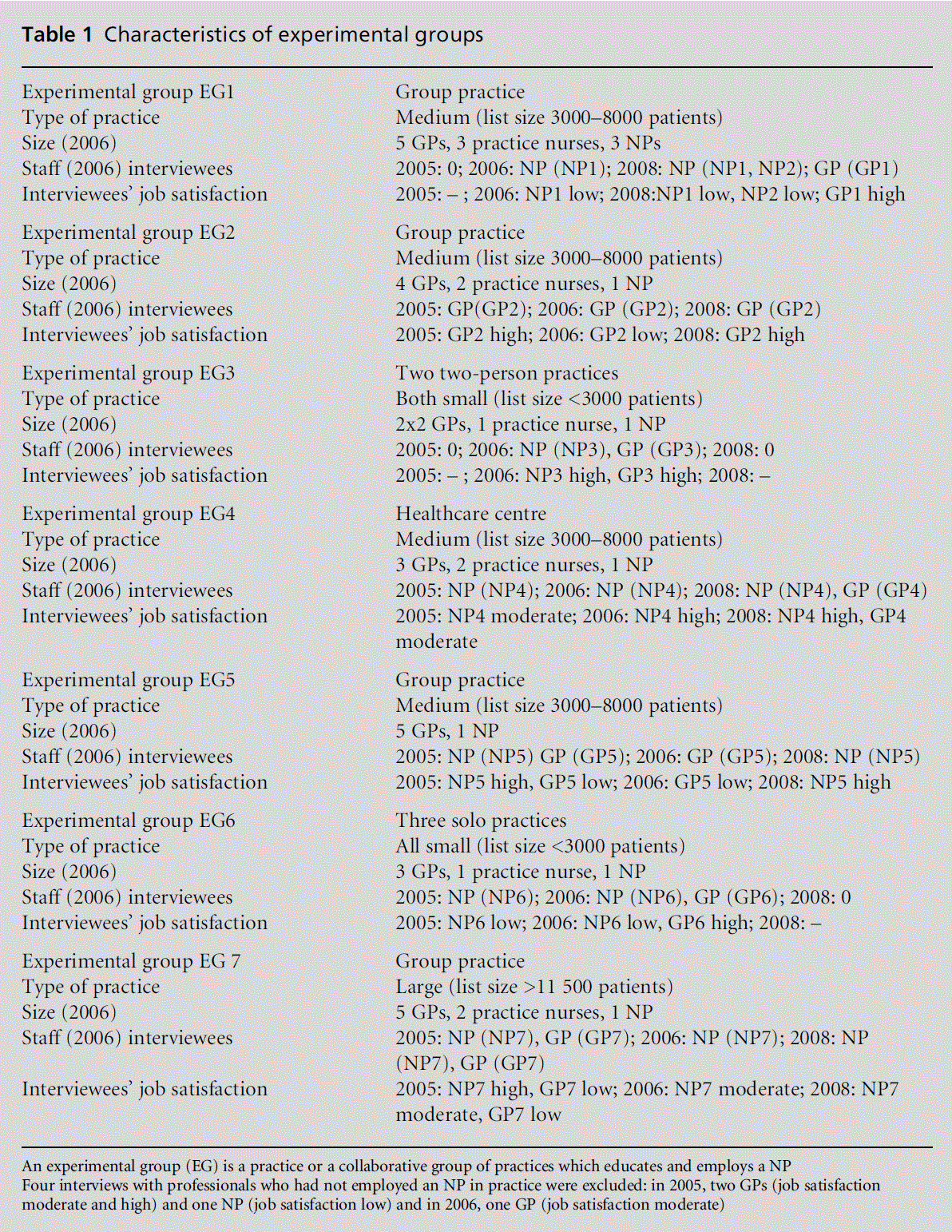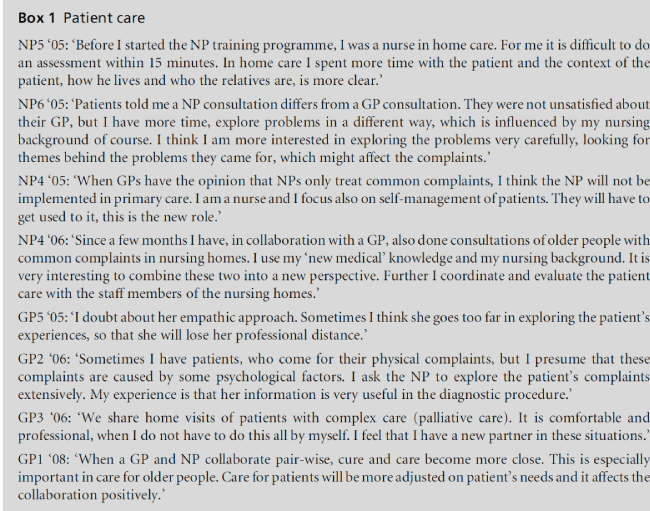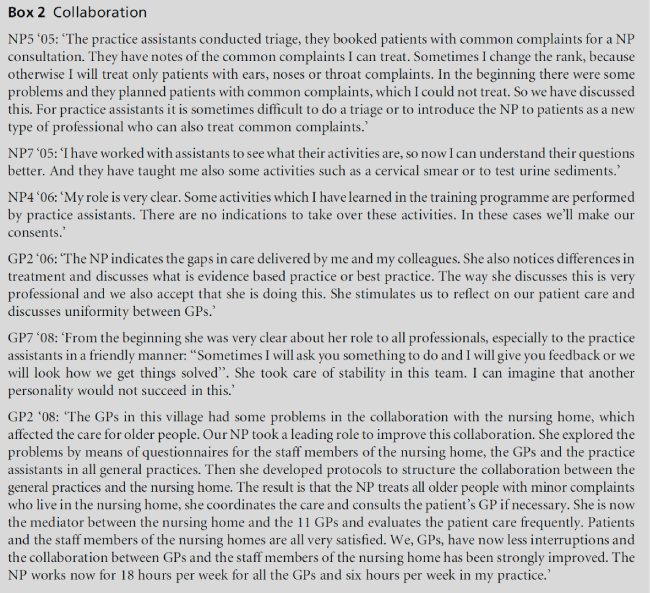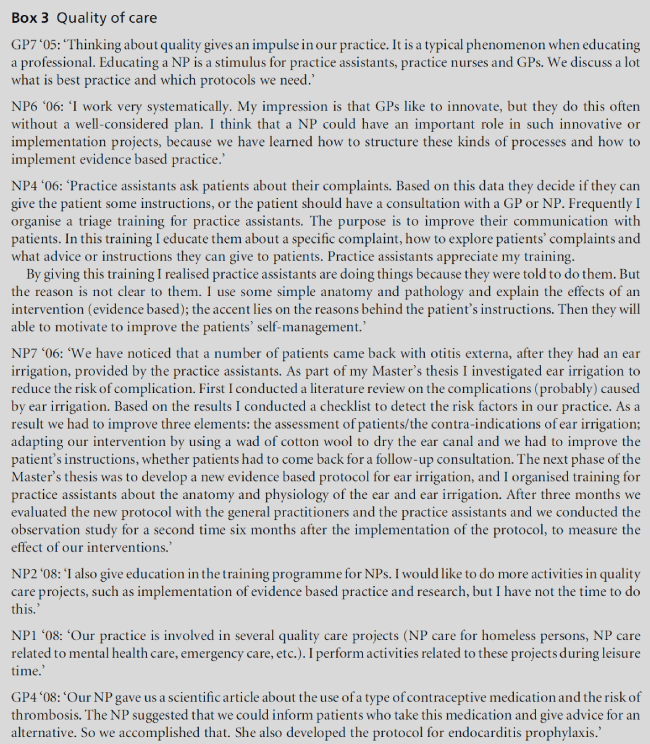Research Paper - (2010) Volume 18, Issue 4
Department of Integrated Care, Maastricht University Medical Centre, Maastricht, The Netherlands
CAPHRI (School of Primary Care and Public Health), Maastricht University Medical Centre, Maastricht, The Netherlands
Foundation for Development of Quality Care in General Practice, Eindhoven, The Netherlands
CAPHRI (School of Primary Care and Public Health), Maastricht University Medical Centre, Maastricht and Department of General Practice, aastricht University Medical Centre, Maastricht, The Netherlands
Foundation for Development of Quality Care in General Practice
Fontys, University of Applied Sciences, Eindhoven, The Netherlands
Research Assistant, Department of Integrated Care, Maastricht University Medical Centre, Maastricht, The Netherlands
Department of Integrated Care, Maastricht University Medical Centre, Maastricht, CAPHRI (School of Primary Care and Public Health), Maastricht University Medical Centre, Maastricht and Department of General Practice, Maastricht University Medical Centre, Maastricht, The Netherlands
Department of Integrated Care, Maastricht University Medical Centre, Maastricht, CAPHRI (School of Primary Care and Public Health), Maastricht University Medical Centre, Maastricht, The Netherlands and TRANZO, Tilburg University, Tilburg, The Netherlands
Received date: 07 January 2009; Accepted date: 1 June 2010
BackgroundHealthcare systems are faced with a changing and increasing demand for care. Against the background of the need to increase service capacity and to improve access to primary care, a project was initiated to introduce the nurse practitioner (NP) role into Dutch general practices. ObjectiveTo explore the value of the NP by describing NP roles and their concordance with the initial concepts of the NP training programme. MethodsAn observational longitudinal design, using mixedmethods, was conducted betweenMarch 2004 and June 2008. A convenience sample of seven NPs and seven teaching general practitioners (GPs), together constituting seven experimental groups, was used. Project documentation and data from consultations between NPs and GPs were collected. Twenty-nine interviews were performed, focusing on NP roles, competencies of NPs and collaboration between professionals. ResultsAs was anticipated, all NPs have patients with common complaints as their main focus, as well as managing the quality of care projects. Differences between NPs are reported in the percentages of time spent in performing home visits, caring for older people, patient related activities and nonpatient related activities. ConclusionNPs contribute to the accessibility and availability of primary care as well as to collaboration in and quality of primary care. The roles they adopt are influenced by practice needs and financial incentives. It is not clear to what degree NPs have to perform activities to improve quality of care and further research is necessary to define NP core competencies.
collaboration, general practice, nurse practitioner, quality of care, substitution
Healthcare systems are faced with changing and increasing demands for care. To guarantee the availability and accessibility of primary care for the near future, an adequate mix of healthcare personnel is one of the prior conditions. This requires reflection on the current roles and responsibilities of health personnel.[1,2] Nurses and doctors have exchangeable skills which make it possible for one to substitute for the other within the area of overlap.
In British and Dutch general practice, practice nurses are common and make a significant contribution to care for the chronically ill.[4,5] The term nurse practitioner (NP) is generally used to identify registered nurses with additional education and training (e.g. a Master’s in Advanced Nursing Practice), who work within an expanded scope of practice that includes diagnosing, prescribing and treating medical conditions within specific settings.[4]
The majority of GPs recognise that NPs can undertake a wide range of clinical activities and are aware of their potential to improve the quality and scope of practice.[3,6] Notwithstanding this, wide divergence in level of autonomy and variations in activities exist in NP roles.[7,8]
Against the background of the need to increase service capacity and to improve access to primary care, a project was initiated to introduce the NP into Dutch general practices. The aim of this study is to explore the value of the NP by describing the NP roles and their concordance with the initial concepts of the NP training programme.
Study design
This study was part of an extensive evaluation study, which has been described in more detail elsewhere.[9] An observational, longitudinal design was conducted between March 2004 and June 2008. We used a selection of quantitative and qualitative research methods.[10,11]
Participants
A convenience sample of seven NPs and seven teaching general practitioners (GPs), together constituting seven experimental groups, was used. NPs were trained and employed in ten participating practices: three single-handed practices, two two-doctor practices, four group practices and one healthcare centre. Table 1 describes the number and type of practices which together formed an experimental group. The teaching GPs had on average 16 years of work experience (SD=10.1). Participating NPs had on average 12 years (SD=7.6) work experience as a (practice) nurse in general practice (n=3), in hospital (n=3) or in an asylum seekers’ centre (n=1). Before they started to work as NPs, the nurses followed a Higher Professional Education Master’s degree in Advanced Nursing Practice (MANP). This training programme ran from March 2004 until February 2006. At the time of data collection all NPs worked part time (0.6 full time equivalent – FTE). More details of the job description

Target population: patients with common complaints
A specified set of common complaints for which patients seek medical attention was compiled. These common complaints will often lead to minor health problems. Patients may have respiratory and throat complaints, ear and nose complaints, musculoskeletal complaints and injuries, skin injuries, urinary complaints, gynaecological complaints and geriatric problems.
Based on triage by the practice assistant, patients with common complaints are referred to the NP. The NP works independently during consultations and home visits. Their activities are according to practice guidelines devised by the Dutch College of General Practitioners: assessing symptoms, physical examinations where appropriate, diagnosing and making decisions for further treatment, prescriptions, referrals to primary or secondary services and clinical investigations. The NP has no full authority to prescribe medications, the GP is always available for consultation and to assign prescriptions. The NP has access to the electronic medical records and reported consultations.
Non-patient related activities
NPs perform both activities to improve collaboration between healthcare professionals within general practice and external partners and activities related to education and quality care projects.
A specific two-year practice oriented training programme was developed, which consisted of the Higher Professional Education Master’s degree in Advanced Nursing Practice (MANP), including general courses and medical courses on managing a specified set of common complaints. General courses were on the training of basic medical skills, role development, collaboration, context of care and research.
Patient care
1 Analyses and interprets patients’(and relatives’) histories, including presenting symptoms, physical findings and diagnostic information, to develop appropriate diagnoses (in a multidisciplinary way)
2 Diagnoses and manages conditions, prioritises health problems and intervenes appropriately, including initiation of effective emergency measures
3 Formulates an action plan based on scientific rationale, evidence based standards of care and practice guidelines, and provides guidance and counselling regarding management of the health/illness conditi
Collaboration
4 Coordinates the patient’s treatment, if necessary, initiates appropriate and timely consultation and/or referral when the problem exceeds the NP’s scope of practice and/or expertise
5 Initiates a professional collaboration with patients and other healthcare professionals
6 Improves the quality of care by means of research and implementing evidence based practice
7 Educates and coaches other professionals to improve their skills
Data from the project documentation were collected in order to explore the initial concepts used for the development of the training programme. Data from consultations and home visits by NPs and GPs, and patients’ ages, complaints and diagnoses were gathered, using the International Classification of Primary Care (ICPC).[12] ICPC codes lower than 70 were labelled as symptoms and complaints and ICPC codes higher than 70 as diagnoses and diseases. These data were gathered retrospectively in five one-month measurements between March 2004 (T0) and October 2007 (T5). In each practice information was given about the relevance of systematically keeping records and registering data. Software was developed to extract data from computer systems. Extracted datawere used during meetings at each general practice to provide feedback and to test the reliability of the documentation.
We conducted qualitative structured interviews at three periods: during June 2005, November 2006 and June 2008. The structure of the interviews was focused on NP roles, competencies and collaboration.[13] The output of the interviews is a taxonomy.[14]
For each of these interviews, NPs and teaching GPs were selected by their mean rates on a developed job satisfaction questionnaire;[15,16] two with the highest rates, one with a rate nearest to the mean and two with the lowest rates to ensure diversity among the informants. So during the study period from 2005 to 2008, the plan was to interview 15 NPs and 15 GPs. Items in the questionnaire (n=15) referred to patient care, organisational characteristics, work characteristics and collaboration, measured by a Likert scale (score 1= very unsatisfied; score 5= very satisfied). The interviews were performed with open-ended questions and conducted by three investigators (AD, HV and CS), using the same instructions and debriefings. Informants were encouraged to speak freely and to raise issues of importance to them. Each interview lasted between 45 and 60 minutes.
The documentation of the initial concepts was explored by the authors and shared with the initiator (TT) of the training programme, in order to validate the concepts. SPSS 15.0 was used to analyse quantitative data. Analyses were undertaken comparing the consultation rates of the NP group and the GP group, based on 1.0 FTE. Descriptive statistics (percentage, mean and standard deviation) were calculated. Consultation units were calculated, based on the assumption that ‘in-house’ NP consultations take 12 minutes,9 and that one home visit is comparable in duration to three consultations (20 minutes per home visit and 16 minutes travel time). Interviews were tape recorded, transcribed verbatim and checked for accuracy. Two authors (AD, HV) read the transcript and coded the answers by using a taxonomy wherein competencies were grouped: patient related care, collaboration and quality of care. The extent of agreement and variation between the three sets of coding was discussed. The authors reviewed and agreed the final broad coding taxonomy to be applied.
Initial concepts
In the development of the training programme three basic concepts were formulated. First, the NPs should assess, diagnose and treat a specified set of common complaints. Therefore, they needed to possess medical knowledge and use practice guidelines on minor health problems derived from the Dutch College of General Practitioners. We expected NP consultations would be longer than GP consultations because they had less medical knowledge and needed time to learn to assess and diagnose.No assumptions were made on how NPs assessed symptoms and complaints (ICPC code <70) or diagnoses and diseases (ICPC code >70). NPs should diagnose at the level of no doubt. Secondly, the NPs should act as professional communicators with patients and other professionals and reflect on their own and others’ functioning. NPs have, from their nursing discipline, a complementary expertise in health education and in assessing the impact of the complaints on patients’ daily activities. As the NPs were also trained in the care of common complaints in older people, medical and nursing competencies should also integrate in this specific care. Finally, NPs should be able to manage projects to improve the quality of care. Therefore, they should develop skills related to education and research.
Figure 2 shows the NP consultation rates in comparison with GP consultation rates (per 1.0 FTE) per month. During the training programme (T0–T2), the NPs’ productivity increased from none to 225 consultations per month. In the period after graduation (T2–T5), consultation rates increased from 115 to 285 consultations per month and the number of home visits increased from1 to 26 per month. The GP consultation rates rose from 325 (T0) to 445 (T5) per month and home visits from 15 (T0) to 33 (T5) per month.
Characteristics of the practices and interviewed professionals, including their individual coding, are described in Table 1. When looking at individual practice, in 2007 NP4 had the most consultations (n=338) and no home visits per month, NP1 the most home visits (n=76) per month, NP6 the fewest home visits (n= 2) and relatively fewer consultations per month (n=283). NP2 was excluded from the analysis, since data from October 2007 were not available. On average NPs had 324.31 (SD=38.64) consultation units per month in 2007. The NPs in EG1 treated relatively more elderly people (12%) than the GPs. In EG5 and EG7 the NPs saw fewer older people than the GPs (–17.6% and –13.6% respectively). In 2007 the NPs assessed on average 2.29% fewer ICPC codes >70 than GPs (mean=59.33%, SD=7.5%and mean=61.61%, SD=11.27 respectively).
We conducted 29 interviews; one GP (whose job satisfaction was low) refused to participate in the interview in 2008 because of the high workload at that moment. We excluded four interviews with NPs from the analyses since the NPs were no longer employed in 2008.
During the first two months of the training programme all NPs joined the GPs during consultations. As soon as NPs finished a specific medical module successfully, they independently treated patients with the corresponding complaint. Two NPs felt they used a different mode from that of GPs for consultations. The combination of working and learning was experienced as difficult for NPs (n=4), with the main reason mentioned being the combination of general courses and medical courses. As one NP (NP4 2005) said:
‘The general part of the training programme is very theoretical and time consuming, but I prefer to do the medical courses; this knowledge I can practically use during my consultations.’NPs (n=4) mentioned being very satisfied with the supervision of the GPs.
Three GPs observed that NPs used a different mode during consultations, focusing on education and stimulating patients’ self-management activities. The NPs’ assessment was too elaborate for them to be able to finish the diagnostic process, but they regarded this as a part of the learning process. The booking interval for a NP consultation was 15 minutes (compared with 10 minutes for GP consultations). GPs regarded the medical knowledge of NPs to be less profound than that of GPs.
In 2006 NPs (n=5) stated that they would like to increase the set of common complaints to include complaints of hands, wrists and elbows, and to care for patients with chronic diseases. GPs (n=4) and NPs (n=5) felt that the NPs carry out their consultations in a responsible and careful way and that they can comprehend the uncertain areas in diagnostic procedures
In 2008 NPs treated on average 20 patients per day. Three NPs also performed small surgical interventions. The average proportion of patient related activities versus non-patient related activities was 75% vs 25%. The minimum percentage of patient related activities was 60% (NP2). In this case, the NP spent much of her time on a quality care project related to care for older people. The maximum percentage of patient related activities was 90% (NP7), with the GP (GP7) mentioned as the main reason for the high productivity in this general practice. All GPs were very satisfied with the NPs as a new professional in general practice. From a medical point of view and in relation to common complaints, GPs have not noticed any differences in the way the NPs act during surgery hours. OneNP (NP4, GP4) would reduce her booking interval to 10 minutes in the future, so she would have more time for other patient related activities. All other NPs remained at 15 minutes. One GP (GP7 2008) stated:
‘It is crucial that the NP has enough time to explore profound problems, this is quality of care.’
From 2006 NPs had a role in care for older people but there are differences between NPs. One GP preferred to treatolder patients himself (GP52006)andoneGPfound that national grants are insufficient for coordinating care for older people when more than 20 GPs have to collaborate with each other (GP7 2008) (Box 1).

In 2005 NPs (n=4) and GPs (n=3) reported that they were satisfied with the collaboration with patients and collaboration with all professionals working in general practice. No gaps in activities or job descriptions were reported. NPs (n=4) stated to pay much greater attention to their collaboration with the practice assistants, and the triage process. If problems with triage occurred, NPs reported that they discussed these with the practice assistants. Further, they mentioned stimulating GPs to adjust their modes and to use protocols.
In 2006, GPs (n=5) reported that NPs’ communication skills are good. As their role in the team is new, they succeed in make their role transparent and colleagues also accept the new role. Three NPs are also involved in patient care for older people in nursing homes, in collaboration with GPs. They hold patient consultations and evaluate patient care with staff members. One NP (NP4 2008) mentioned that the group of NPs in primary care is still very small. Public relations and communication about the new role both inside and outside the practice remain very important (Box 2).

NPs (n=5) in 2005 participated in quality improvement projects. All GPs recognised that with the introduction of the NP quality improvement has been realised by the development of standards and protocols. NPs also have a role in the education of practice assistants and in projects to improve quality of care. In 2008, five NPs and four GPs experienced the role of the NP in quality care projects: the development and implementation of protocols based on evidence, the accreditation of Dutch national guidelines and the introduction of care pathways for older people. In Box 3 examples of these activities are described.

This study lends clarity to the role of NPs in general practice. NPs’ main focus of work is on the treatment of patients with common complaints. In this way the added value of NPs is that they contribute to the accessibility and availability of primary care, but also to the improvement of quality of care in general practice. The learning curve of NPs treating patients with common complaints is suggested by the increase of productivity rates towards the end of the study. The increase after graduation is partly influenced by incentives to make the NP economically viable and partly attributed to changes in the Dutch health insurance system. Differences between productivity rates of NPs and GPs can arguably be explained by differences in booking intervals.
Differences between NPs are reported in the percentages of home visits, the care for older people and the percentages of patient related activities versus non-patient related activities for different practices. These results are attributed to the preference of GPs to perform certain consultations themselves, the funding which supports coordinated care for older people from health insurance allowances and the specific needs of practices to perform non-patient related activities. Consequently, the way NPs perform their roles is a result of their collaboration with other professionals in general practice as well as of financial incentives. Another study found similar results related to the variation in clinical freedom and autonomy of NPs’ work at practice level.[17]
From a medical point of view, GPs have not noticed any difference between the way NPs act during the treatment of patients with common complaints compared with themselves, which is also reported in earlier publications.[5,9,18] As NPs mainly treat patients with common complaints this might also lead to GPs having more time for patients with chronic diseases or multi-morbidity.
NPs are hybrid professionals, synthesising nursing and medical skills.[18] TheMaster’s training programme is a major precondition for the success of the autonomous role of the NP. In the curriculum NPs experienced a tension between medical and general courses. For NPs the patient population is new, which makes medical courses crucial to their effective performance in practice. Otherwise general courses related to role development, collaboration and research are crucial in order to enable them to perform activities in the improvement of (evidence based) patient care.[13,19,20] Characteristics attributed toMaster’s graduates, which are also concordant with this study, can be categorised under cognitive and practice related competencies, research orientation and personal dynamism.[21] Collaborative models for education are recommended in order to develop the potential value of NPs.[7]
Several studies postulate the importance of nonpatient related activities, to challenge traditional values and transform clinical practice in an ever-changing healthcare system,[8] but these activities are often not reimbursed. Researchers, professionals and healthcare insurers should debate the importance of these activities and quantify them to indicate potential cost savings. Additional robust research is needed to operationalise the core competencies of NPs in general practice.
One of the most important advantages in using multiple methods is that this can lead to theoretical and substantive insights into the multidimensional nature of healthcare systems.[14] This study had some limitations. Descriptive studies do not report the full range of responses. Issues have to be identified and considered for a certain level of evidence.[22] Further, not all the data for consultation rates of the NP in EG2 were available to the researchers, since she worked for a group of GPs who did not participate in the project. Bias might have occurred because the evaluation setting was not anonymous. Further, the interviewers had different professional backgrounds. By using the same instructions and debriefings, the authors assumed that the variation in interviewing styles was limited. In our analyses we have not used data from four interviews with professionals because in these practices the NPs finished their job before 2007, whereas it was our intention to focus on general practices with four years of experience of NPs.
Nurse practitioners are functioning with a primary focus on the treatment of patients with common complaints. In doing so, they contribute value by increasing the accessibility and availability of primary care and also contribute to improvements in quality of care. Differences in roles are mostly influenced by specific needs in practices and by financial incentives. Additional research is needed to validate the results and to operationalise the core competencies of NPs in general practice
The authors would like to thank the patients, practice assistants, nurse practitioners and general practitioners for their invaluable contribution to this paper. Thanks are also extended to the Dutch Ministry of Health, Welfare and Sport and the Health Insurances CZ and Univit for funding and the associates of Meetpunt Kwaliteit, who had an important role in data extraction from the computer systems.
Dutch Ministry of Health, Welfare and Sport and the Health Insurances CZ and Univit, Foundation ROS Robuust, Province of North-Brabant, The Netherlands.
Informed consent was obtained and Ethical Approval for the study was obtained from the local Medical Ethical Judgement Committee, Eindhoven, The Netherlands
None.